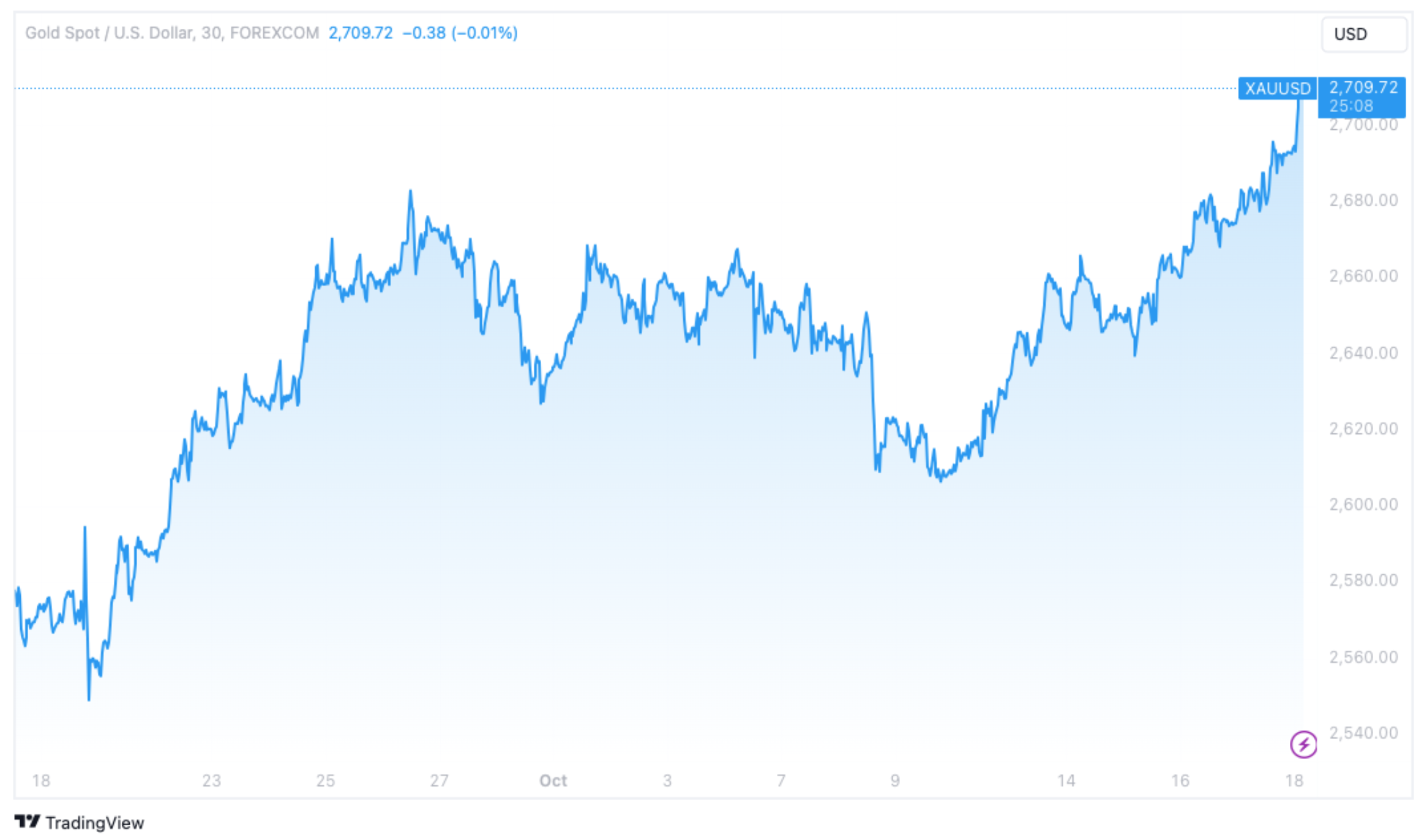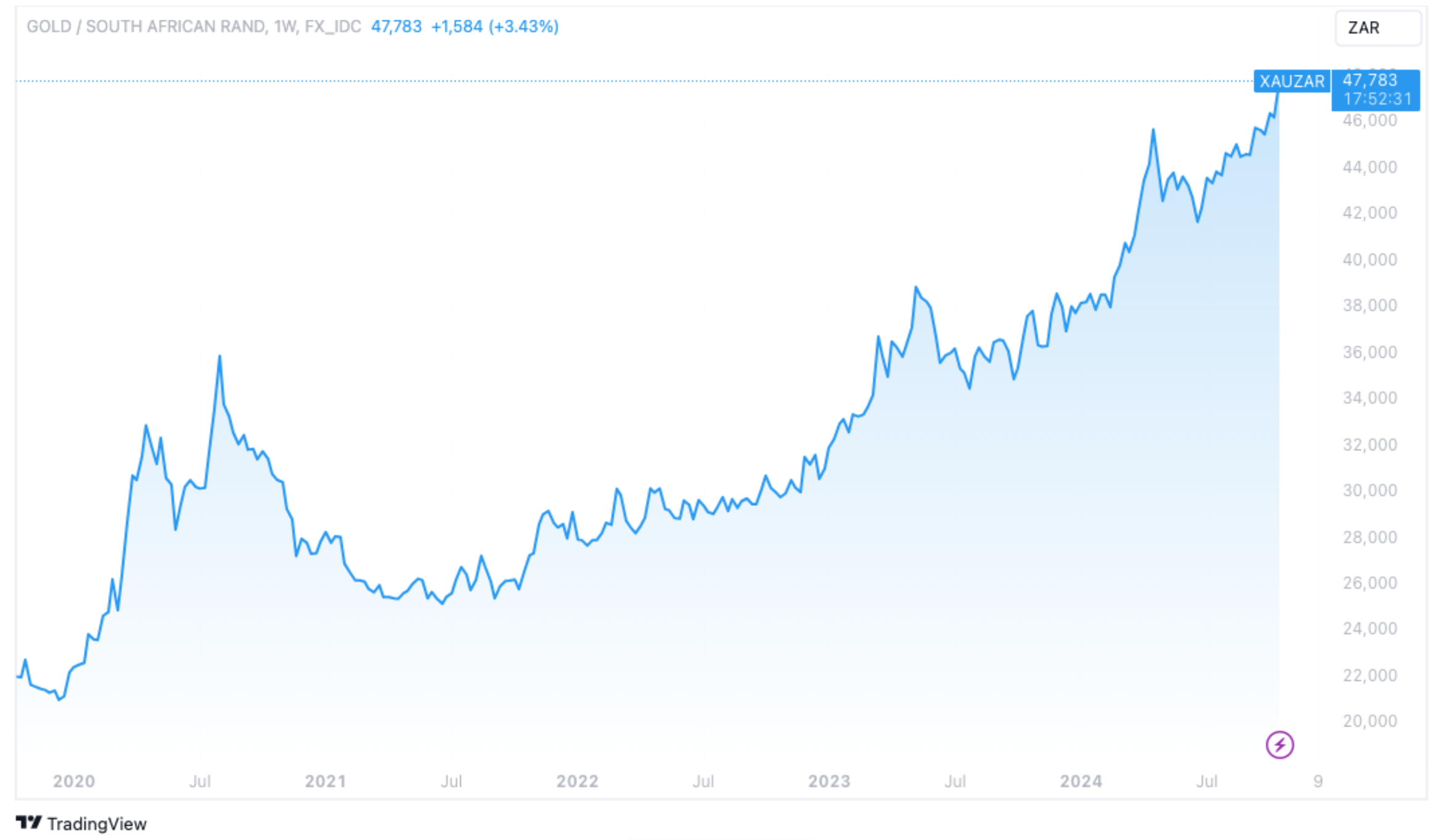
The gold price has seen remarkable outperformance in 2024 due to several key factors - the threat of widespread war sparked by current conflicts in the Middle East, the continued NATO and Ukraine alliance versus Russia war, government stimulus and spending packages by governments across the globe, an impending U.S election, U.S Fed rate cuts and ever-widening government budget deficits funded by historic debt loads.
The U.S. Fed lowered the Fed Funds rate by 0.5% in September for the first time since July 2019. They did that because U.S. inflation cooled down to 2.25% (the Fed’s target is 2%) and the labour market also cooled i.e jobs growth slowed - they then believe inflation should ideally be muted going forward). Consequently, market pundits expect further rate cuts next year as the Federal Reserve just switched into easy money mode and is likely to fire up formal QE in the near future. Rate cuts are good for gold.
Similar stimulus and money printing are being seen in other countries like China, where it wants to keep up appearances and reach the 5% GDP target for 2024. Xi’s administration introduced a broad package of monetary stimulus packages with the PBoC pumping over $140 billion of Yuan into the stock market, sending the equities markets into an artificial rally of over 4%. This is merely debt-based growth which means price rises and positive returns in risk assets like equities and credit will come at the expense of their national currencies in future. The European Union and India are amongst the other big economic players who have also introduced both fiscal and monetary stimulus in 2024 to prop up growth.
All in, governments have borrowed too much money from the future. The U.S. and many other countries are reaching a tipping point with debt – where their production output can’t service the debt and the only solution is to sacrifice the currency’s completely by printing accelerating amounts of it to pay for the interest expense.
Total global debt just reached $315 trillion, which is 333% of global GDP output. U.S. debt is at a staggering $36 trillion and doubles every eight years. The effect of accelerating sovereign debt means governments will debase their currency to pay for it, as there’s not enough growth in production and tax receipts can’t pay for it. As a result, you’ve seen central banks being significant players in the gold market, making record-high purchases in recent years. In 2022, they bought 1,083 tonnes of gold, followed by 1,037 tonnes in 2023. Buying 483 tonnes in 2H24 would total 967 tonnes for 2024, 52% above the 2013-2024 average. This reflects a trend of nations using gold as monetary safety – their demand is expected to remain strong over the next 2-4 years.
Probably the most important short-term factor driving gold’s safe-haven demand is the uncertainty in the U.S. election. With only 20 days left until Americans vote, the future policies, both financial and i.t.o. international relations could be vastly different depending on who wins. Harris would likely institute a neocon strategy of expensive forever wars and engaging in multiple conflicts, whereas Trump would advance a more protectionist policy of trying peace deals, but with costly tariff policies.
Also - Troygold, that gold fintech, has launched a veritable GOLD STANDARD FOR SOUTH AFRICANS by making your Troy Mastercard linkable to your gold holdings… so you now really can save and spend and ‘live’ in gold bullion. No Rands needed. The thought experiment then now is – with the Rand losing over 20% a year to gold – why not escape Rand inflation and rather store savings and spend only with gold?
“The stage is set for a powerful precious metals bull market cycle. The problems facing the world are not going away anytime soon. Even if all the conflicts end tomorrow, and they won’t, we’re still facing a structural debt problem of unprecedented magnitude. Further conflict and spending will just add gas to the fire.” Says Adam Sharp of DailyReckoning.com, who writes alongside gold expert Jim Rickards.
Between yesterday and today, both the Rand and US gold prices set new records of $2,709/oz and ZAR 47,800/oz. In returns terms (hold onto your seat):

I mentioned in my previous letter that gold has entered a new realm of pricing because it has become a barometer for the fiscal and monetary policy actions undertaken globally - effectively a measure for the stimulus and debt-based globs of money being pumped into global markets by central bankers and their friends in oval offices. Gold is a proper macro asset now, and it appears that gold’s continued outperformance aligns directionally quite well with global stimulus and debt’s rise.
We believe gold can gain further ground as global conflicts continue and debt levels rise, but a real boost would come if the West’s consumer demand for gold investment sees growth, which could come if interest rates return to lower or pre-Covid levels, in 2025.
In my best Yoda voice - stacking, you must keep on.

